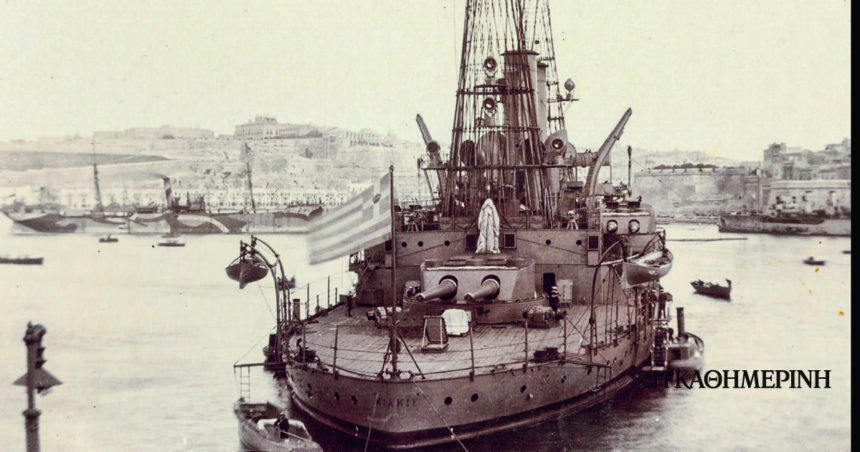The operation of the Greek state under the name “Golden Fleece” for the evacuation of the Greek populations from warriima Abkhazia took place on August 15, 1993 and was one of the recent examples of the continued presence and interest of Hellenism on the coasts of Black and on the coasts. In the third decade of the 21st century, the area is again at the center of world interest and Hellenism of the area is once again a danger and insecurity for its future.
Returning back in time, there at the end of World War I, SOA 1918, we see the Greek Ploys again pulling the well -known naval path to the Black/Axan Pontus. The mission of the Hellenic Navy and Army to the Black Sea, Crimea and in the wider Odessa area, shortly after the end of the war, will be a bargaining weapon at the Greek Government for its claims on Asia Minor. Head of Naval Forces is defined by Admiral G. Kakoulides and the land forces the commander of the 1st Army Corps, General Mr Nider.
The first business outside the modern Greek state is relatively unknown and fractured for both land and maritime operations that took place during and after and after it.
“Against Little Team”
The transfer of the 1st Army Corps, which had taken the order to operate in the fields of Odessa and Crimea, would be carried by ships from ports in Northern Greece. The port of Thessaloniki, the bay of the Cross and the port of Eleftherias, were the embarkation points of the units that would participate in the campaign, “… but under the basis of the French naval Squadron of the East, that these ports are exposed to the winds and that they would not be exposed to the winds and the winds. of each ship or group of intents immediately as they approach it and departed immediately. “
The narrow passage is done with caution and use of a pilot as they had not been cleared by minefields and other obstacles such as the submerged, from 1915, before the Straits
Allies ships.
The embarkation of the first sections of the 34th Infantry Regiment of the Second Infantry Division begins on 2/15 January 1919 in the “Tigre” (“Normandie” (“Normandie”) steamships. The lack of suitable port facilities in the ports of Stavros and Eleftheron has imposed the loading of heavy materials and vehicles only from the port of Thessaloniki. For the other two ports, small ships were made to transport the staff from the coast to ships. On the same day, he sails from Thessaloniki and the “Seine” steamboat with a hospital of 520 beds.
“January 2, 1919 (Wednesday). Departure from Thessaloniki 14, through the steamship “Seine”. Captain HermandèLieutenant Commander RabalantFournier’s steam physician, “the doctor writes in his diary Nikolaos Sbarounis – Trikorfos, Director of the Second Military Hospital of Odessa and Odessa and Advisor Surgeon of the Hellenic Expeditionary Corps. Amphitrite floating hospital was also available at the expedition to meet its needs.
The transfer of the Second Division continues with the steamships “Redestos”, “Kherson” (“Hersoni”), “Bellarosia” (“Bellarossie”), “Varna” (“Varna”), and “Khios” (“Chios”). The narrowing of the straits is cautiously and the use of a navigator since they had not been cleared by minefields and other obstacles such as the submerged, in 1915, before the narrow ships of the Allies.
Initial design, times and mode of transport have presented many variations and problems. This was contributed by the poor design of the business but also the speed at which the situation was evolving in the area. These factors influenced the original design. The transfer rate proved to be extremely slow.
Following the transfer of the Second Division, the transfer of the ten -third division with the steamships “Emperor Nikolaos”, “Euphrates”, “Jerusalem”, “Emperor Alexander” and “Emperor Petros” followed.
Two Battalions of the 1st Spis with their arrival in Odessa and, at the order of the French administration, were taken to the steamships “Potemkin” and “Anna II” and headed to the Hersona to reinforce the besieged by the Bolshevik forces. Due to seasonal conditions, most of the ports approaches were made with the help of icebreakers.
The sea road was also chosen for the transport of sections from Nikolayev, when it was evacuated by the 7th SPA sections with the “Varna” and “Raidestos” steamships. The operation soon ended and with no substantive results for the Allied troops. Characteristic of the speed of the situation is that while the sending of troops from Greece still continued, it was decided to evacuate Odessa in March of the same year.
On 18/31 March the evacuation of the city is announced by general order by the allies’ nationals. General Nider calls on his telegram to send passenger ships to transport the Greeks in the area and those who had turned there. The “extremely urgent” document to the Foreign Ministry announced, a telegram by Admiral Kakoulides reads: “Odessa has been expanded militarily quietly. Bolsheviks occupied politically. Army recedes normally to Akkerman. General Nider on “Syria”. Abundance of transport, but only about 10 thousand Greeks boarded. They were leaving and slower to the beach. “
Two battalions with their arrival in Odessa and, at the order of the French administration, were taken to steamships and headed to the Hersona to reinforce the besieged by the forces of the Bolsheviks, a guard.
With 11 ships
The participation of the Greek ships was made in the context of the operation designed by the Allied forces. The entrance of the Greek and French fleet into the Black Sea had preceded the entrance of the English fleet in October 1918, after the signing of the truce from Turkey and the subsequent opening of the Dardanelles.
Greece participated in the campaign with eleven ships despite the problems that its fleet was facing at that time. The problems of the fleet were mostly due to the state of the ships and to the staff. The French had seized the Greek fleet in 1916 as a reaction and as a form of pressure due to the obsession with the neutrality of Greece in World War I.
The ships were returned in poor condition and with many shortcomings in 1917, after taking over the governance by Eleftherios Venizelos. The “Kilkis” and “Lemnos” battleships were among those seized with the rest of the Greek fleet. The national divide in turn had caused many problems to the staff, creating rivalries and hatred among executives. “World War I and his division of Greece had the worst influence on Greek Navy officers until then,” the Admiral writes E. Kavvadias.
The ships involved in the operation were the “Kilkis” and “Lemnos” battleships, the flexible “G. Averoff “(shields), the destroyers (1,176 tonnes)” eagle “,” Irax “,” Leo “and” Panther “, the destroyer (750 tonnes)” thunder “and the destroyers (350 tonnes)” arrow “,” storm “. The Kilkis battleship participated as the ship of the Light Fleet of the Macedonian Lieutenant General G. Kakoulidis, BPN (Dec. 1917 – 28 Sep 1918). Kakoulidis was knowledgeable of the Russian language and had received retraining for five years in the Russian Navy and the Crostand Artillery School.
The presence of the Greek war fleet in the Black Sea area lasted from November 1918 to March 1920, while the land forces for more than three months.
The missions
The main missions assigned to the Greek naval forces were to participate in the effort to rescue the Russian fleet, the support of land operations and maritime control.
The absence of organization and coordination by those who have the French responsibility was evident on all aspects of the business. In his book Stylianou Haratsi “The First Intervention” through the Archive of the Commander of the “Panther”, Vice -Commander I. Giannokosta We find reports and unknown details about the prevailing conditions.
Particularly problematic was the situation on supply and administrative care. The ships of the ships had to find solutions on their own so that they could fulfill their mission. A typical example is the reference to the “panther” governor, who was unable to find fuel for the auxiliary gas station, but also the fact that the battleships accompanied by destroyers were towing them to save fuel.
Problems were also presented in health care as there were no Allied services that could assist. The presence of the Greek forces, in addition to being done at a time when the weather and temperatures were extreme, coincided with the surge of the Spanish influenza epidemic. Aphrodisiac diseases have also increased, as stated in reference by Lieutenant Giannokostas to the fleet commander.
The missions they undertook, in addition to the operational, extended from the transfer of staff (licensed, detached, transferred) to the transfer of the mail, various materials and supplies, spare parts and anything necessary. The ships were the cohesive link between the land and naval forces in the area and the Hellenic Military Committee of Constantinople (ESAK).
The military adventure in the Black Sea with the end of World War I and the participation of the Greek fleet and the land forces of the 1st Army Corps followed by Asia Minor Campaign. Fleet units and army formations after their reconstruction on the territory of Romania were promoted to Smyrna, which at that time seemed to justify the belief that “the road to Asia Minor passes through Ukraine”.
*Mr. Spyros Karamoutsos is a PhD candidate, Ionian University and the Center for Maritime History / Institute of Mediterranean Studies – FORTH. (www.ims.forth.gr)






